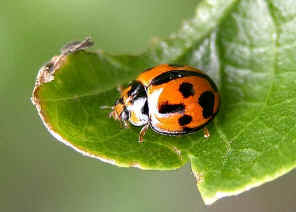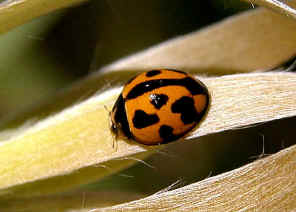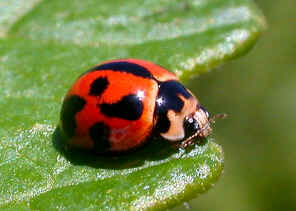|
| |
FAMILY COCCINELLIDAE
- This page contains information and pictures about Variable Ladybird Beetles
that we found in the Brisbane area, Queensland, Australia.
-
 - Body length 5mm
-
- The ladybirds are bright orange-yellow in
colour with four various pattern black dot on each wing-covers. There is a
black line at the meeting edges of the wing-covers. The dot patterns are
various between individual.
-
 
- For every colony of the Milkweed Aphids
we found, we always see this ladybirds hiding somewhere nearby.
-

 -
- In the first picture above, the ladybird adult just catch a Milkweed Aphid
and looking for a place to eat it. The Milkweed Aphids suck the juice of
milkweed so we believe the aphids are toxic themselves, for the aphids store
the chemical of the Milkweed plants in their body. The ladybird must have evolved the solution to
overcome the toxic.
-
  -
- The ladybird female are about the same size , or a
bit larger than the male.
-
Eggs
- After mating, the female lay a batch of eggs, about
ten, on leaf surface.
-
-
 
-
Eggs, length 1.5mm
-
Larva
- About a week, the larvae hatch from the eggs. They are black in colour and
may be mistaken as ants. They start to look for the aphids as their first
meal.
-
  - 1st instars, length 3mm
2nd instars, 5mm
-
- Most other insect larvae consume their own eggs shells when hatched, as their first
meal. The ladybird larvae seem do not do that. We also found that ladybird larvae do
not eat their moulted skin in all instars stage.
-
  - Later instars, length 7mm, 8mm
-
- Ladybird larva is not easy to be identified. Different species may look similar. Ladybird
larvae do not resemble adults.
They are soft-bodied and are variously coloured with spots and are adorned with
spines. Their short legs
protrude out from their elongate bodies, which are often dark with brightly
colored markings. As in the pictures above, larvae are usually found in aphid colonies.
-
-
 
-
- In our backyard, we have a red flower Hibiscus plant. In early spring, the
number of aphids built up. A week later the ladybirds caome and very soon the
number of aphids was under control. The above first picture shows two ladybird larvae hunting the Cowpea Aphids
on the Hibiscus plant. Usually we easily find both adult and larva
hunting on the same plant if the plant infected by those aphids.
-
 -
Pupa
- Ladybird larvae develop rapidly. The larva emerges from the eggs takes 1-2
weeks. The larva reaches maturity within 2 weeks. Pupation takes place on
plants where the larva fed and the adult emerges from the pupa after 1-2
weeks.
-
  -
- The pupa has the same colour as adult. This pupa took about 8 days to turn into an
adults, during summer..
-
The Variable Patterns
-


-
-

-
- The dot patterns are highly variable between individual. The above
pictures are some examples. Please also see the Variable Ladybird 2
and Variable Ladybird 3 pages.
-
- Reference:
- 1. Australian Ladybird Beetles
(Coleoptera: Coccinellidae) Their biology and
classification - A.Ślipiński, Australian Biological Resources,
2007, p158.
- 2. 九星瓢蟲
- Insects of Taiwan.
-
[ Up ] [ Transverse Ladybird ] [ Variable Ladybird 1 ] [ Variable Ladybird 2 ] [ Variable Ladybird 3 ] [ Common Spotted Ladybird ] [ Three-banded Ladybird ] [ Netty Ladybird ] [ Striped Ladybird ] [ Fungus-eating Ladybird ] [ Spotted Amber Ladybird ]
| |
|





















